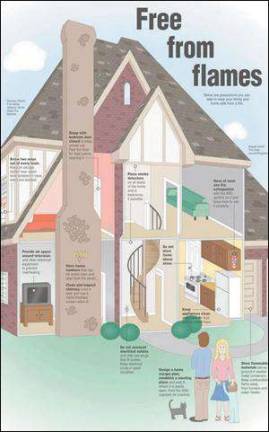Free from flames

Fire-prevention tips from the roof to the floor, By Amanda Reavy J.T. Somer takes no chances when it comes to fire safety. Before he leaves his house, Somer checks for appliances left running or plugged-in. He writes the date on smoke detector batteries each time they’re replaced. And when he lights a match, he runs it under the faucet before discarding it. Such precautions are second nature to the Illinois State Fire Marshal, who encourages everyone to be proactive in home fire prevention. Many people underestimate the risk of home fires and display life-threatening errors in judgment when it comes to fire safety, he said. And, most people don’t realize how quickly they must evacuate a burning house. A small flame can grow out of control in less than 30 seconds, and thick, black smoke can engulf a room in mere minutes, according to the U.S. Fire Administration. On average, you have about two minutes to safely escape. “A big misconception about fires, thanks to movies and television, is that you can see,” Somer said. “If there’s a real fire, there’s a strong chance that you’re not going to be able to see your own hand in front of your face.” The foremost precaution people must take is devising an escape plan and safe meeting place away from the home to call for help, he said. Somer said families with small children should review and practice their escape plan together at least twice a year. Residents also should make sure they have a way to evacuate upper levels. He recommends keeping a fire escape ladder near one of the main upper level windows. “Ideally, there should be one for every bedroom,” Somer said. People also should sleep with the bedroom door closed to keep smoke out and allow more time to escape. Another crucial fire safety precaution is smoke detectors, he said. Working smoke alarms reduce the risk of death in a home fire by 50 percent. About 70 percent of all home fire fatalities occur in homes with no smoke alarms or no working smoke alarms, according to the National Fire Protection Association. To be fully effective, smoke detectors must be installed in appropriate locations. Foremost, detectors should be placed in a home’s sleeping quarters, Somer said. “Most people are killed in their sleep (during fires),” he said. Detectors should also be placed outside the kitchen and inside doorways to the garage and outside. In multi-story homes, the devices should be on every floor and at the bottom and top of each stairwell, he said. Somer recommends purchasing smoke detectors with an integrated system, where one alerted detector sets off every detector in the home. It also is important for residents to check that their detectors’ batteries are working and properly installed at least twice a year, such as during the spring and fall time change. Somer said carbon monoxide detectors also should be placed near furnaces, hot water heaters and garage doors. Carbon monoxide is an odorless, toxic gas that causes flu-like symptoms, including nausea, dizzy spells, fatigue and vomiting.